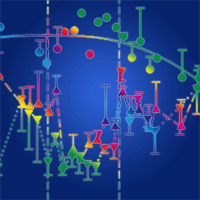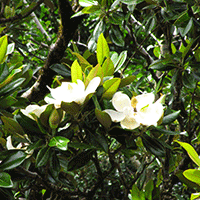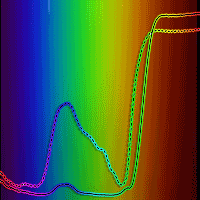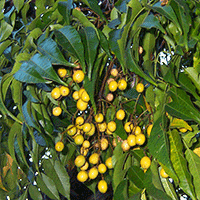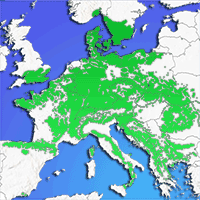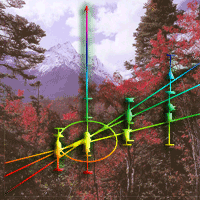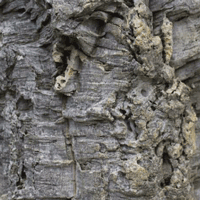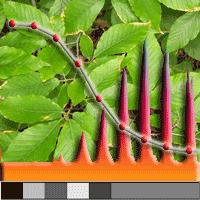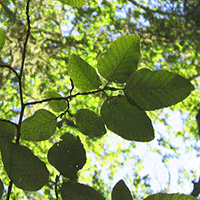Former studies using the chlorophyll fluorescence technique on evergreen Ilex aquifolium L. showed that its photosynthetic potential for electron transport in winter recovers quickly when exposed to more favorable conditions. Since little is known, however, about its photosynthetic carbon gain in winter, we investigated its leaf gas exchange over an entire winter and spring period. Measurements were made rotationally in the field and in the laboratory to also investigate if I. aquifolium profits from warmer phases during winter in terms of net carbon gain. From the end of autumn until the end of spring, three different climate-driven phases of photosynthetic responses could be distinguished: first, an acclimation phase which lasted until February and was characterized by a gradually decreasing light-saturated gross photosynthesis (Amax(gross)), decreasing apparent quantum yield of CO2-assimilation (ΦΦi) and a decreasing ability of these parameters to recover overnight inside the laboratory. At the same time, maximal quantum yield of PSII (Fv/Fm) could fully regenerate. In this phase, single warmer days had a positive effect on carbon assimilation. Second, a phase of relatively constant but low photosynthesis which was virtually unaffected by temperature, lasting for almost two months occurred. Here, Amax(gross) and Φi had lost their ability to recover from winter conditions in the field, while Fv/Fm was much less affected. I. aquifolium was still able to conduct positive light-saturated net photosynthesis at a leaf temperature of -0.5 °C, but during this time it could not profit from milder temperatures in terms of carbon gain. Third, a phase of increasing photosynthesis (spring recovery) occurred, starting in March when the 5-day average temperature was above 5 °C and radiation in the field increased, and where all parameters slowly recovered from winter depressions. Our findings show that I. aquifolium is photosynthetically active over the whole winter, even at temperatures around 0 °C. In terms of carbon gain, however, I. aquifolium does not profit from warmer phases during winter, despite the fast recovery seen in chlorophyll fluorescence measurements.
Keywords
, , , , ,
Citation
Wachendorf M, Schloz M, Küppers M, Güney A, Veste M (2019). Wintertime photosynthesis and spring recovery of Ilex aquifolium L.. iForest 12: 389-396. - doi: 10.3832/ifor2983-012
Academic Editor
Claudia Cocozza
Paper history
Received: Oct 23, 2018
Accepted: May 21, 2019
First online: Jul 31, 2019
Publication Date: Aug 31, 2019
Publication Time: 2.37 months
© SISEF - The Italian Society of Silviculture and Forest Ecology 2019
Open Access
This article is distributed under the terms of the Creative Commons Attribution-Non Commercial 4.0 International (https://creativecommons.org/licenses/by-nc/4.0/), which permits unrestricted use, distribution, and reproduction in any medium, provided you give appropriate credit to the original author(s) and the source, provide a link to the Creative Commons license, and indicate if changes were made.

Breakdown by View Type
(Waiting for server response...)
Article Usage
Total Article Views: 44626
(from publication date up to now)
Breakdown by View Type
HTML Page Views: 37840
Abstract Page Views: 3261
PDF Downloads: 2671
Citation/Reference Downloads: 6
XML Downloads: 848
Web Metrics
Days since publication: 2322
Overall contacts: 44626
Avg. contacts per week: 134.53
Article Citations
Article citations are based on data periodically collected from the Clarivate Web of Science web site
(last update: Mar 2025)
Total number of cites (since 2019): 3
Average cites per year: 0.43
Publication Metrics
by Dimensions ©
Articles citing this article
List of the papers citing this article based on CrossRef Cited-by.
(1)
Arrieta S, Suárez F (2006)Marginal holly (
Ilex aquifolium L.) populations in Mediterranean central Spain are constrained by a low-seedling recruitment. Flora 201: 152-160.
CrossRef |
Gscholar
(2)
Banuelos MJ, Kollmann J, Hartvig P, Quevedo M (2004)Modelling the distribution of
Ilex aquifolium at the north-eastern edge of its geographical range. Nordic Journal of Botany 23: 129-142.
CrossRef |
Gscholar
(3)
Bauer H, Nagele M, Comploj M, Galler V, Mair M, Unterpertinger E (1994)Photosynthesis in cold acclimated leaves of plants with various degrees of freezing tolerance. Physiologia Plantarum 91: 403-412.
CrossRef |
Gscholar
(4)
Berger S (2008)Evergreen broad-leaved woody species: indicators of climate change. PhD thesis, Naturwissenschaftliche Fakultät, Gottfried Wilhelm Leibniz Universität Hannover, Hannover, Germany, pp. 121.
Gscholar
(5)
Bowling DR, Logan BA, Hufkens K, Aubrecht DM, Richardson AD, Burns SP, Anderegg WRL, Blanken PD, Eiriksson DP (2018)Limitations to winter and spring photosynthesis of a Rocky Mountain subalpine forest. Agricultural and Forest Meteorology 252: 241-255.
CrossRef |
Gscholar
(6)
Busch F, Hüner NPA, Ensminger I (2007)Increased air temperature during simulated autumn conditions does not increase photosynthetic carbon gain but affects the dissipation of excess energy in seedlings of the evergreen conifer Jack pine. Plant Physiology 143: 1242-1251.
CrossRef |
Gscholar
(7)
Bussotti F, Pollastrini M, Holland V, Brüggemann W (2015)Functional traits and adaptive capacity of European forests to climate change. Environmental and Experimental Botany 111: 91-113.
CrossRef |
Gscholar
(8)
Chazdon RL, Pearcy RW (1986)Photosynthetic responses to light variation in rainforest species. I. Induction under constant and fluctuating light conditions. Oecologia 69: 517-523.
CrossRef |
Gscholar
(9)
DWD (2014)Deutschlandwetter im Winter 2013/14 [Germany’s weather in the 2013/14 winter]. Deutscher Wetterdienst, Pressemitteilung, Offenbach, Germany. [in German]
Online |
Gscholar
(10)
Ensminger I, Busch F, Huner NPA (2006)Photostasis and cold acclimation: sensing low temperature through photosynthesis. Physiologia Plantarum 126: 28-44.
CrossRef |
Gscholar
(11)
García-Plazaola JI, Olano JM, Hernandez A, Becerril JM (2003)Photoprotection in evergreen Mediterranean plants during sudden periods of intense cold weather. Trees 17: 285-291.
Online |
Gscholar
(12)
Gillies SL, Vidaver W (1990)Resistance to photodamage in evergreen conifers. Physiologia Plantarum 80: 148-153.
CrossRef |
Gscholar
(13)
Groom QJ, Baker NR, Long SP (1991)Photoinhibition of holly (
Ilex aquifolium) in the field during the winter. Physiologia Plantarum 83: 585-590.
CrossRef |
Gscholar
(14)
Havranek WM, Tranquillini W (1995)Physiological processes during winter dormancy and their ecological significance. In: “Ecophysiology of Coniferous Forests” (Smith WK, Hinckley TM eds). Academic Press, San Diego, USA, pp. 95-124.
CrossRef |
Gscholar
(15)
Huner NPA, Öquist G, Hurry VM, Krol M, Falk S, Griffith M (1993)Photosynthesis, photoinhibition and low temperature acclimation in cold tolerant plants. Photosynthesis Research 37: 19-39.
CrossRef |
Gscholar
(16)
Iversen J (1944)Viscum, Hedera and
Ilex as climate indicators. Geologiska Föreningen i Stockholm Förhandlingar 66: 463-483.
CrossRef |
Gscholar
(17)
Kaiser E, Morales A, Harbinson J, Kromdijk J, Heuvelink E, Marcelis LFM (2015)Dynamic photosynthesis in different environmental conditions. Journal of Experimental Botany 66: 2415-2426.
CrossRef |
Gscholar
(18)
Katahata SI, Han Q, Naramoto M, Kakubari Y, Mukai Y (2014)Seasonal changes in temperature response of photosynthesis and its contribution to annual carbon gain in
Daphniphyllum humile, an evergreen understorey shrub. Plant Biology 16: 345-353.
CrossRef |
Gscholar
(19)
Mediavilla S, Escudero A (2003)Photosynthetic capacity, integrated over the lifetime of a leaf, is predicted to be independent of leaf longevity in some tree species. New Phytologist 159: 203-211.
CrossRef |
Gscholar
(20)
Míguez F, Fernández-Marín B, Becerril JM, García-Plazaola JI (2015)Activation of photoprotective winter photoinhibition in plants from different environments: a literature compilation and meta-analysis. Physiologia Plantarum 155: 414-423.
CrossRef |
Gscholar
(21)
Öquist G (1983)Effects of low temperature on photosynthesis. Plant, Cell and Environment 6: 281-300.
CrossRef |
Gscholar
(22)
Öquist G, Huner NPA (2003)Photosynthesis of overwintering evergreen plants. Annual Review of Plant Biology 54: 329-355.
CrossRef |
Gscholar
(23)
Ottander C, Öquist G (1991)Recovery of photosynthesis in winter-stressed Scots pine. Plant, Cell and Environment 14: 345-349.
CrossRef |
Gscholar
(24)
Pott R (1990)Die nacheiszeitliche Ausbreitung und heutige pflanzensoziologische Stellung von
Ilex aquifolium L. [Post-glacial distribution and current phyto-sociological role of
Ilex aquifolium L.]. Tuexenia 10: 497-512. [in German]
Gscholar
(25)
Savitch LV, Leonardos ED, Krol M, Jansson S, Grodzinski B, Huner NPA, Öquist G (2002)Two different strategies for light utilization in photosynthesis in relation to growth and cold acclimation. Plant, Cell and Environment 25: 761-771.
CrossRef |
Gscholar
(26)
Slot M, Wirth C, Schumacher J, Mohren GMJ, Shibistova O, Lloyd J, Ensminger I (2005)Regeneration patterns in boreal Scots pine glades linked to cold-induced photoinhibition. Tree Physiology 25: 1139-1150.
CrossRef |
Gscholar
(27)
Suni T, Berninger F, Vesala T, Markkanen T, Hari P, Mäkelä A, Ilvesniemi H, Hänninen H, Nikinmaa E, Huttula T, Laurila T, Aurela M, Grelle A, Lindroth A, Arneth A, Shibistova O, Lloyd J (2003)Air temperature triggers the recovery of evergreen boreal forest photosynthesis in spring. Global Change Biology 9: 1410-1426.
CrossRef |
Gscholar
(28)
Sykes MT, Prentice IC, Cramer W (1996)A bioclimatic model for the potential distributions of North European tree species under present and future climates. Journal of Biogeography 23: 203-233.
Online |
Gscholar
(29)
Valladares F, Arrieta S, Aranda I, Lorenzo D, Sánches-Gómez D, Tena D, Suárez F, Pardos JA (2005)Shade tolerance, photoinhnibition sensitivity and phenotypic plasticity of
Ilex aquifolium in continental-Mediterranean sites. Tree Physiology 25: 1041-1052.
CrossRef |
Gscholar
(30)
Veste M, Kriebitzsch WU (2010)Die Stechpalme - ein Gewinner des Klimawandels? [Holly - a winner of global warming?]. AFZ-DerWald 16: 16-18. [in German]
Gscholar
(31)
Wachendorf M, Küppers M (2017)Effects of leaf temperature on initial stomatal opening and their roles in overall and biochemical photosynthetic induction. Trees 31: 1667-1681.
CrossRef |
Gscholar
(32)
Walther G, Berger S, Sykes MT (2005)An ecological “footprint” of climate change. Proceedings of The Royal Society B 272: 1427-1432.
CrossRef |
Gscholar
(33)
Way DA, Pearcy RW (2012)Sunflecks in trees and forests: from photosynthetic physiology to global change biology. Tree Physiology 32: 1066-1081.
CrossRef |
Gscholar
(34)
Wieser G (1997)Carbon dioxide gas exchange of cembran pine (
Pinus cembra) at the alpine timberline during winter. Tree Physiology 17: 473-477.
CrossRef |
Gscholar
